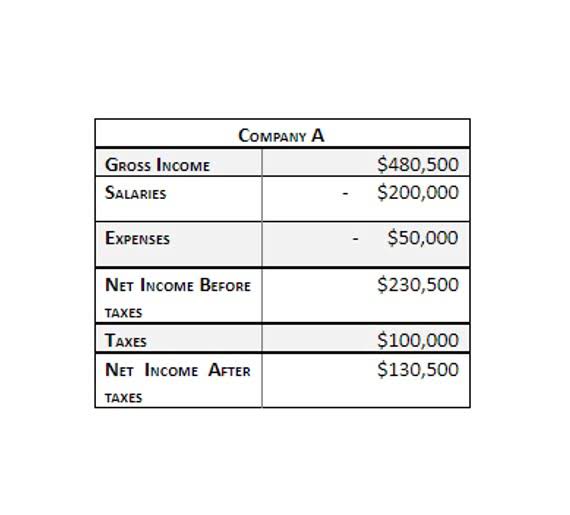
Properly allocating indirect costs allows organizations to understand the full cost of their activities and make informed decisions. The indirect rate formula provides a way to systematically share overhead costs. In the case of Justin’s barbershop, he might estimate the total cost of a cleaning service for the year to be $12,000 and the number of visits to be twice a month. Therefore, instead of choosing the number of visits, Justin could have chosen to use the number of hours typically spent cleaning. The selection of an activity base can be changed from period to period, should the circumstances make it reasonable. Indirect costs include expenses such as the salaries of the project manager and administrative staff, renting office space to manage the project, and insurance and legal fees.
Are indirect costs also known as common costs?
Indirect labor (part of manufacturing overhead) includes the production supervisors who oversee production for several different boats and product lines. Absorption is the method in which all project costs, both direct (like materials and labor) and indirect (like office rent or project management fees), are allocated to specific construction tasks or phases. Each task or phase of the work “absorbs” a proportionate share of the total costs. In this article, we’ll navigate the landscape of indirect costs in the construction industry, highlighting the different types and their importance for success and profitability. Indirect costs would be the utilities, administrative and marketing expenses and salaries involved in running of the overall business that cannot be easily assigned to a specific car production unit.
The global economic burden of health anxiety/hypochondriasis- a systematic review – BMC Public Health – BMC Public Health
The global economic burden of health anxiety/hypochondriasis- a systematic review – BMC Public Health.
Posted: Mon, 13 Nov 2023 08:00:00 GMT [source]
Proper management of overheads enhances overall cost efficiency

As the owner of a startup or small business, you should understand the distinction between direct and indirect costs when pricing your products or services. When you know the true costs involved with producing and providing your goods or services to customers, you can price both competitively and accurately. Additionally, certain costs are tax-deductible, so properly tracking both direct and indirect https://www.bookstime.com/articles/is-bookkeeping-a-dying-profession costs can help you maximize deductions. Finally, if you ever apply for and receive a grant, there are several rules around the types of indirect costs and the maximum amount you can claim. The key is to choose an allocation base that has a clear relationship to the indirect costs being allocated. This helps ensure an equitable distribution across different projects, departments, products, etc.
- Monitoring indirect cost rates each year also helps reveal trends and opportunities to optimize operations.
- Let’s imagine that, rather than working for the water supply company, you are in a management position for a stationery and greeting card store.
- This classification allows businesses to decide the price for any product or project using the broken down and classified information.
- Finally, if you ever apply for and receive a grant, there are several rules around the types of indirect costs and the maximum amount you can claim.
- Therefore, instead of choosing the number of visits, Justin could have chosen to use the number of hours typically spent cleaning.
General and Administrative (G&A) costs
These examples illustrate how overheads encompass various expenses that are necessary for the smooth operations of a business. By understanding the distinction between overheads and direct costs, businesses can better analyze their overall financial performance and allocate resources more efficiently. The allocation base is the chosen measure or standard used to distribute indirect costs among various projects, tasks, indirect costs are also referred to as costs. or phases within those projects. Soft costs are expenses that are not directly tied to the labor, materials, and equipment that go into building the structure. They are typically intangible and administrative in nature, often incurred before the construction begins or after it concludes. For example, common soft costs on a project include architectural and design fees, permitting fees, and land acquisition costs.
- A charitable organization may have a salaried employee who works in three areas of the organization.
- If they are not properly addressed, they can lead to misunderstandings in the cost structure of an organization.
- One of the methods to address indirect costs is the predetermined overhead rate (PDOR), which looks at estimating the cost of an indirect cost based on an activity it involves.
- Justin’s source of revenue — his business — is providing haircut and grooming services.
- Examples of indirect costs include utilities, maintenance on equipment, miscellaneous supplies, salaries, and administrative expenses.
- If your organization wants to negotiate a NICRA and NEH is its cognizant agency, see Guidance for Negotiating an Indirect Cost Rate Agreement with NEH.
- The result of this calculation represents the allowable indirect costs for the project.
Importance: Top 5 Benefits of Cost Management
You can reduce other indirect costs, like advertising, by engaging customers through social media or using other inexpensive marketing ideas. Indirect costs are also referred to as overheads, administrative costs, or facility costs. All these terminologies are synonymous and mostly used in the replacement of one another. Examples of general and administrative costs include salaries and bonuses of top executives and the costs of administrative departments, including personnel, accounting, legal, and information technology. In an industry where past trends can inform future decisions, data analytics and predictive tools can play a large role. By analyzing historical data, these tools can identify patterns in indirect cost overruns or savings, providing valuable insights for future projects.
- Indirect costs in construction refer to expenses that, while not directly tied to a specific building or structure, are essential for the overall execution of a project.
- Most federal sponsors require periodic financial reports that track direct and indirect costs incurred against the approved budget.
- For example, if a business fails to include indirect costs when calculating profit margins, the resulting figures may falsely indicate higher profitability than what is actually being achieved.
- To more fully understand indirect costs, it is important to break them down further into either indirect product or period costs.
- As you review the monthly invoices, you find many invoices for expenses that have nothing directly to do with water bottling or distribution.
- Because these costs are necessary for keeping your business running but aren’t directly related to any one project, allocating them can be tricky from an accounting perspective.
Indirect costs refer to expenses that are difficult to directly assign to a specific project or product. Understanding how to track and allocate indirect costs is an important part of accounting and budget management. Examples of indirect costs include utilities, maintenance on equipment, miscellaneous supplies, salaries, and administrative expenses.

- Common examples include administrative salaries, utilities, and facility maintenance.
- The classification of total costs into direct and indirect costs allows management to take important decisions to survive and grow in the era of cut-throat competition, by adopting different cost strategies.
- Common or indirect costs differ from direct costs, which are expenses specifically related to a particular project or activity and can be directly traced to that project.
- This is an example of how direct and indirect costs appear on a company’s income statement.
Indirect costs are important to consider when estimating the total cost of a construction project. Accurately accounting for indirect costs helps to ensure that the project remains financially viable and profitable for the construction company. Understanding the difference between overheads and indirect costs is vital for effective financial management and decision-making within a business. By correctly identifying and categorizing these expenses, companies can gain better control over their budgeting, forecasting, and overall financial performance. These examples highlight the diverse nature of indirect costs and the wide range of expenses that fall under this category. As businesses grow and evolve, it becomes increasingly important to accurately identify and track these indirect costs to ensure effective financial management.